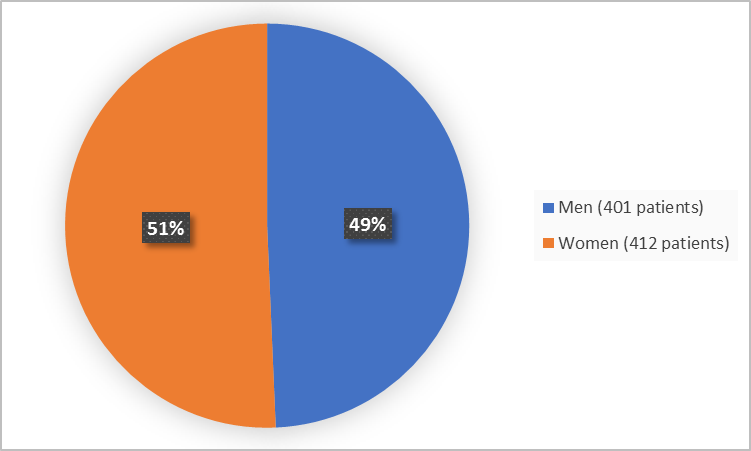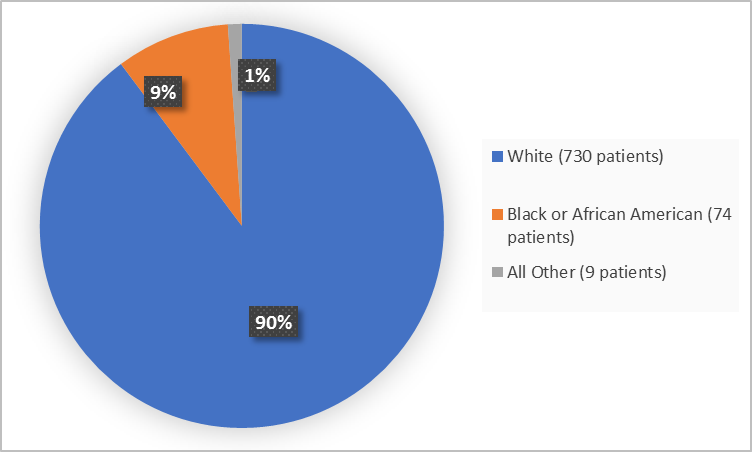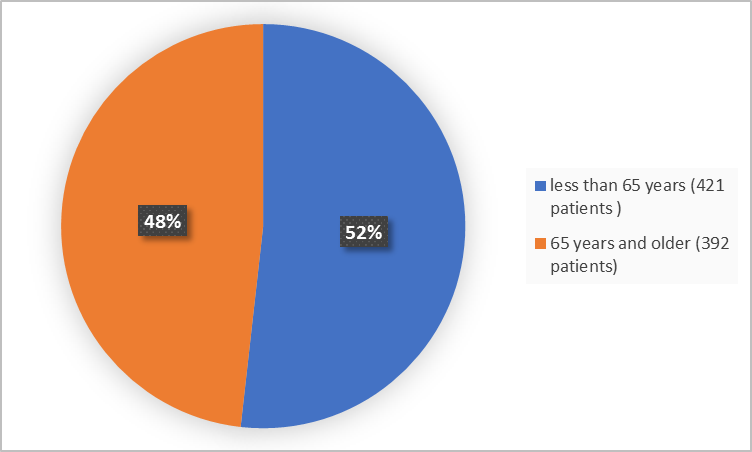Drug Trials Snapshots: YUPELRI
HOW TO USE THIS SNAPSHOT
The information provided in Snapshots highlights who participated in the clinical trials that supported the FDA approval of this drug, and whether there were differences among sex, race, and age groups. The “MORE INFO” bar shows more detailed, technical content for each section. The Snapshot is intended as one tool for consumers to use when discussing the risks and benefits of the drugs.
LIMITATIONS OF THIS SNAPSHOT:
Do not rely on Snapshots to make decisions regarding medical care. Always speak to your health provider about the risks and benefits of a drug. Refer to the YUPELRI Prescribing Information for complete information.
YUPELRI (revefenacin)
you-PELL-ree
Mylan
Approval date: November 9, 2018
DRUG TRIALS SNAPSHOT SUMMARY:
What is the drug for?
YUPELRI is a drug for the maintenance treatment of adults with a lung disease called COPD (chronic obstructive pulmonary disease).
How is this drug used?
YUPELRI is a solution used with nebulizer. Patients should use YUPELRI breathing treatment once a day.
What are the benefits of this drug?
YUPELRI relaxes the muscles in the airways. This allows air to move easier in the lungs which helps prevent symptoms such as wheezing, cough, chest tightness, and shortness of breath.
What are the benefits of this drug (results of trials used to assess efficacy)?
Table 2 below summarizes the co-primary efficacy endpoints for each trial separately based on the Intent-to-treat (ITT) analysis set defined as all randomized patients who received at least one dose of trial drug, and, had at least one recorded post-baseline peak FEV1 (forced expiratory volume in 1 second).
The primary endpoint was change from baseline in trough (pre-dose) FEV1 at Day 85.
Table 2. LS Mean Change from Baseline in Trough FEV1 (mL) on Day 85 (ITT)
| Trial 1 | Trial 2 | |||
|---|---|---|---|---|
| Placebo (N = 209) |
YUPELRI (N = 198) |
Placebo (N = 208) |
YUPELRI (N = 197) |
|
| n* | 191 | 189 | 187 | 181 |
| LS Mean (SE) | -19 (16.1) | 127 (15.4) | -45 (18.8) | 102 (18.5) |
| LS Mean Difference (SE) from Placebo | -- | 146 (21.6) | -- | 147 (25.5) |
| 95% CI for LS Mean Difference from Placebo | -- | (103.7, 188.8) | -- | (97.0, 197.1) |
LS – Least Square, SE – Standard Error
*n=patients in ITT population used in the statistical analyses
YUPELRI Prescribing Information
Were there any differences in how well the drug worked in clinical trials among sex, race and age?
- Sex: YUPELRI worked similarly in men and women.
- Race: The majority of patients in the trials were White. Differences in how well YUPELRI worked among races could not be determined.
- Age: YUPELRI worked similarly in patients younger and older than 65 years of age.
Were there any differences in how well the drug worked in clinical trials among sex, race, and age groups?
The tables below summarize the responses to YUPELRI compared to placebo for the pooled populations.
Table 3. Subgroup Analysis of Primary Endpoint (FEV1 on Day 85) in Pooled Trials
| Pooled Trials | Placebo | YUPELRI |
|---|---|---|
| Sex: Male, N LS Mean (SE) |
N=206 -24.3 (17.7) |
N=195 138.3 (16.9) |
| LS Mean Difference vs. Placebo (95% CI) | 163.6 (122.5, 204.8) | |
| Sex: Female, N LS Mean (SE) |
N=211 -41.5 (17.4) |
N=200 90.9 (17.2) |
| LS Mean Difference vs. Placebo (95% CI) | 133.3 (92.9, 173.7) | |
| Race: White, N LS Mean (SE) |
N=379 -36.1 (13.1) |
N=350 121.5 (12.7) |
| LS Mean Difference vs. Placebo (95% CI) | 157.5 (122.8, 192.2) | |
| Race: Others, N LS Mean (SE) |
N=38 -6.3 (37.8) |
N=45 60.1 (37.6) |
| LS Mean Difference vs. Placebo (95% CI) | 66.4 (-37.8, 170.6) | |
| Age: <65 years, N LS Mean (SE) |
N=219 -25.40 (16.8) |
N=202 120.4 (16.8) |
| LS Mean Difference vs. Placebo (95% CI) | 145.8 (100.1, 191.5) | |
| Age: >= 65 years, N LS Mean (SE) |
N=198 -42.0 (18.2) |
N=193 109.5 (17.2) |
| LS Mean Difference vs. Placebo (95% CI) | 151.5 (103.9, 199.1) |
N = Number of subjects; SE = Standard Error; CI = Confidence Interval
Adapted from FDA Statistical Review
What are the possible side effects?
YUPELRI can cause serious side effects, including:
- Sudden shortness of breath that may be life-threatening
- New or worsening eye problem called narrow-angle glaucoma
- New or worsening problems with urination: symptoms can include difficulty passing urine or painful urination
- Serious allergic reactions
The most common side effects of YUPELRI include cough, runny nose, upper respiratory tract infection, headache, and back pain.
What are the possible side effects (results of trials used to assess safety)?
The table below summarizes adverse reactions for the two pooled trials. The population represented is the safety population, which includes any patient who received at least one dose of trial drug.
Table 4. Adverse Events with YUPELRI ≥2% Incidence
| Placebo (N=418) |
YUPELRI (N=395) |
|
|---|---|---|
| Respiratory, Thoracic and Mediastinal Disorders | ||
| Cough | 17 (4%) | 17 (4%) |
| Infections and Infestations | ||
| Nasopharyngitis | 9 (2%) | 15 (4%) |
| Upper respiratory tract infection | 9 (2%) | 11 (3%) |
| Nervous System Disorders | ||
| Headache | 11 (3%) | 16 (4%) |
| Musculoskeletal and Connective Tissue Disorders | ||
| Back pain | 3 (1%) | 9 (2%) |
YUPELRI Prescribing Information
Were there any differences in side effects among sex, race and age?
- Sex: The occurrence of overall side effects was higher in women.
- Race: The majority of patients in the trials were White. Differences in side effects among races could not be determined.
- Age: The occurrence of overall side effects was similar between patients younger and older than 65 years of age
Were there any differences in side effects of the clinical trials among sex, race, and age groups?
The tables below summarize adverse events in the pooled two trials by subgroups.
Table 5. Summary of Treatment-Emergent Adverse Events by Sex- (Safety Analysis Set)
| Men | Women | |||
|---|---|---|---|---|
| Placebo (N=206) | YUPELRI (N=195) | Placebo (N=212) |
YUPELRI (N=200) | |
| Any TEAE, n (%) | 102 (49.5) | 93 (47.7) | 104 (49.1) | 110 (55.0) |
| Serious TEAE, n (%) | 13 (6.3) | 5 (2.6) | 8 (3.8) | 10 (5.0) |
Table 6. Summary of Treatment-Emergent Adverse Events by Race - (Safety Analysis Set)
| White | Black or African American | |||
|---|---|---|---|---|
| Placebo (N=380) | YUPELRI (N=350) | Placebo (N=37) |
YUPELRI (N=37) | |
| Any TEAE, n (%) | 192 (50.5) | 186 (53.1) | 13 (35.1) | 14 (37.8) |
| Serious TEAE, n (%) | 18 (4.7) | 11 (3.1) | 3 (8.1) | 4 (10.8) |
Table 7. Summary of Treatment-Emergent Adverse Events by Age Group - (Safety Analysis Set)
| <65 years | ≥65 years | |||
|---|---|---|---|---|
| Placebo (N=219) | YUPELRI (N=202) | Placebo (N=199) |
YUPELRI (N=193) | |
| Any TEAE, n (%) | 96 (43.8) | 109 (54.0) | 110 (55.3) | 94 (48.7) |
| Serious TEAE, n (%) | 17 (7.8) | 10 (5.0) | 4 (2) | 5 (2.6) |
Clinical Trial Data
WHO WAS IN THE CLINICAL TRIALS?
Who participated in the clinical trials?
The FDA approved YUPELRI based on evidence from two clinical trials (Trial 1: NCT02459080 and Trial 2: NCT02512510) which included 813 adult patients with COPD. The trials were conducted at 119 sites in the United States.
Figure 1 summarizes how many men and women were enrolled in the clinical trials.
Figure 1. Baseline Demographics by Sex
Clinical Trial Data
Figure 2 and Table 1 summarize the percentage of patients by race enrolled in the clinical trials.
Figure 2. Baseline Demographics by Race
Clinical Trial Data
Table 1. Demographics by Race
| Race | Number of Patients | Percentage |
|---|---|---|
| White | 730 | 90 |
| Black or African American | 74 | 9 |
| Asian | 4 | 1 |
| American Indian or Alaska Native | 1 | less than 1 |
| Multiple Race | 4 | 1 |
Clinical Trial Data
The figure below summarizes the age of patients in the clinical trial.
Figure 3. Baseline Demographics by Age
Clinical Trial Data
Who participated in the trials?
Table below sumarises demographics of safety population from the pooled trials.
Table 8. Baseline Demographics for the Trials (safety population)
| Demographic Parameter | Placebo (N = 418) |
YUPELRI (N = 395) |
Total (N=813) |
|---|---|---|---|
| Sex, n (%) | |||
| Men | 206 (49.3) | 195 (49.4) | 401 (49.3) |
| Women | 212 (50.7) | 200 (50.6) | 412 (50.7) |
| Race, n (%) | |||
| White | 380 (90.9) | 350 (88.6) | 730 (89.8) |
| Black or African American | 37 (8.9) | 37 (9.4) | 74 (9.1) |
| Asian | 0 | 4 (1.0) | 4 (0.5) |
| American Indian or Alaska Native | 0 | 1 (0.3) | 1 (0.1) |
| Multiple Race | 1 (0.2) | 3 (0.8) | 4 (0.5) |
| Subject Age (Years) | |||
| Median | 64.0 | 64.0 | 64.0 |
| Min, Max | 42, 88 | 41, 87 | 41, 87 |
| Age Group, n (%) | |||
| < 65 Years | 219 (52.4) | 202 (51.1) | 421 (51.8) |
| ≥ 65 Years | 199 (47.6) | 193 (48.9) | 392 (48.2) |
| Ethnicity, n (%) | |||
| Hispanic or Latino | 16 (3.8) | 16 (4.1) | 32 (3.9) |
| Not Hispanic or Latino | 398 (95.2) | 372 (94.2) | 770 (94.7) |
| Not Reported | 4 (1.0) | 6 (1.5) | 10 (1.2) |
| Unknown | 0 | 1 (0.3) | 1 (0.1) |
| Geographic Region, n (%) | |||
| United States | 418 (100) | 395 (100) | 813 (100) |
Clinical Trial Data
How were the trials designed?
There were two trials that evaluated the benefit and side effects of YUPELRI. In each trial, patients with moderate to very severe COPD were randomly assigned to receive breathing treatment with either YUPELRI or placebo once daily. Neither the patients nor the health care providers knew which treatment was being given until after the trials were completed.
The trials compared YUPELRI and placebo by measured how well air flows through the lungs from the beginning of the trials until the end.
How were the trials designed?
There were two 12-week, randomized, double-blind, placebo-controlled, multiple dose, parallel-group trials in adult patients with moderate to very severe COPD according to the Global Initiative for Obstructive Lung Disease (GOLD) 2011 guidelines. Patients were current or ex-smokers with ≥ 10 pack-year smoking history, with a post-bronchodilator FEV1 of < 80% of predicted normal and greater than 0.7 L, an FEV1/FVC ratio less than 0.70.
Trials 1 and 2 evaluated YUPELRI and placebo administered once daily via a standard jet nebulizer. The primary endpoint was change from baseline in trough (pre-dose) FEV1 at Week 12 (Day 85).
GLOSSARY
CLINICAL TRIAL: Voluntary research studies conducted in people and designed to answer specific questions about the safety or effectiveness of drugs, vaccines, other therapies, or new ways of using existing treatments.
COMPARATOR: A previously available treatment or placebo used in clinical trials that is compared to the actual drug being tested.
EFFICACY: How well the drug achieves the desired response when it is taken as described in a controlled clinical setting, such as during a clinical trial.
PLACEBO: An inactive substance or “sugar pill” that looks the same as, and is given the same way as, an active drug or treatment being tested. The effects of the active drug or treatment are compared to the effects of the placebo.
SUBGROUP: A subset of the population studied in a clinical trial. Demographic subsets include sex, race, and age groups.



